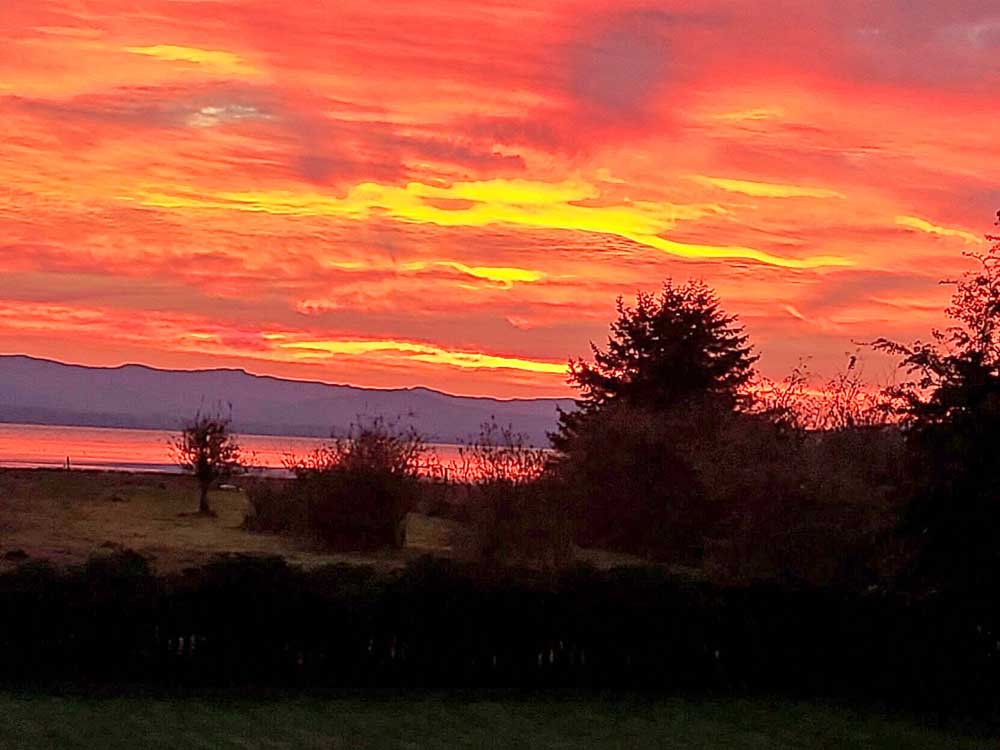Elementary, my dear… Thin places and the spaces between us
Published 7:02 am Monday, December 4, 2023

- A November Sunrise over Willapa Bay in Oysterville — a stunning reminder of the saying in Irish Celtic lore: “Thin places are those locales where the veil between this world and the otherworld is porous, where there is mystery in the landscape.”
When I think about the thin places, I’m not thinking personal thin places — like maybe my earlobes. Nor am I thinking about spas or gyms or stationary bicycles or any other places to get thin. No, what I’m talking about is more like a concept — a term widely used by mystics and those who write about Celtic Spirituality.
Trending
According to those who study such things, the term thin place comes from the pre-Christian culture in western Europe — particularly Ireland — and refers to a place where the veil between this world the “other world” or the “eternal world” is thin. Old tales tell of people and beings of the other world being able to pass back and forth between worlds in thin places.
This idea often refers to holy sites, but it also refers to in-between places and times (dawn, dusk, forest edges, the seashore). Apparently in these landscapes that are not quite one thing and not quite another, the spirit world has an easier time breaking through. More than one person has told me that Oysterville is such a place.
I don’t disagree. I’ve known all my life that there’s something special about Oysterville. Some say it’s a quality of the light. Some say it’s the vast quiet. Some say that here you get a sense of going back in time. Yes, say I. Yes, to all the above. Call it whatever you want. For me “one of the thin places” will do.
Trending
In fiction and non-fiction
This autumn, as the days grow shorter and the weather worsens, I’ve been reading the works of two very different authors. I’ve just completed the first nine books of Diana Gabaldon’s “Outlander Series” — not the television adaptations, mind you. It’s the space between Gabaldon’s words and my mind that has filled in some of the gaps in my understanding of thin spaces. Who knew that in a combination of historical fiction, sci-fi, and steamy romance, I would find some answers to my questions about thin places.
Gabaldon, of course, does not use the term “thin places.” She writes, instead, about the special places in Scotland (where, incidentally, there are reputed to be many, many thin places) where it is possible for certain people to travel back and forth through time. She makes a good case for ley lines and electrical impulses and genetic proclivities. I can almost believe her suggestions…
At the same time, I’ve been reading Yuval Noah Harari’s “Sapiens: A Brief History of Humankind” and am looking forward to reading its companion book, “Homo Deus, A Brief History of Tomorrow.” Harari is an Israeli author, public intellectual, historian and professor in the Department of History at the Hebrew University of Jerusalem.
He writes about a “cognitive revolution” that supposedly occurred roughly 70,000 years ago when Homo sapiens supplanted the rival Neanderthals and other species of the genus Homo, developed language skills and structured societies, and ascended as apex predators. Their journey was aided by the agricultural revolution and accelerated by the scientific revolution, which have allowed humans to approach near mastery over their environment. He uses familiar-sounding data and writes simply and understandably about scientific discoveries and perceptions that we’ve all heard touched upon but seldom thought deeply about.
And so betwixt the two of them…
Both Harari and Gabaldon are masters at building upon commonly held beliefs and assumptions and taking them forward a step, two steps, and then by gigantic leaps into logical scenarios that open new vistas. Or at least, so it seems to me. In fact, so closely do both authors follow our history — Harari from 70,000 years ago and Gabaldon from only a few centuries ago — and so cleverly do they explain the unexplainable, I have a hard time not accepting all of their premises.
Time travel? Why not? And, if that is a possibility as Gabaldon makes me want to believe, why not travel to other worlds? Through the thin places. I remember going to Stonehenge in 1958 — back in the days when there were no fences or barriers keeping the giant henge enclosed or separating it from the vast expanse of Salisbury Plain. That day only Charlie and his dad and I were there. We sat amid those gigantic standing stones and ate our picnic lunch, feeling their majesty and wondering who and how and why… Had I known about thin places then, would my experience have been different?
Meanwhile, though I’m only halfway through Harari’s “Sapiens,” I’m already anticipating its companion, Homo Deus. The blurbs on the back cover are intriguing: “War Is Obsolete.” “Famine Is Disappearing.” “Death is Just a Technical Problem.” “What Does Our Future Hold?” As I read those phrases, I wonder if we will, indeed, morph into a planet of bots in Harari’s vision of the future? Will other worlds in space be a part of our future? And, if so, will time travel be involved? Wherever could we find a veil so thin?
Perhaps right here… in Oysterville.









